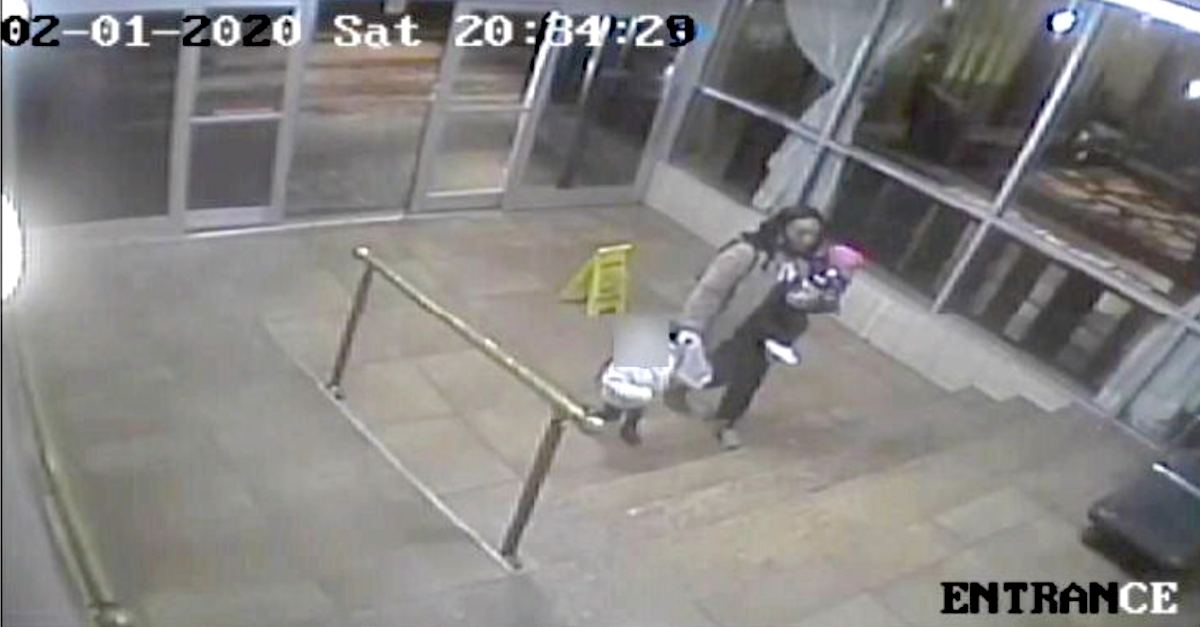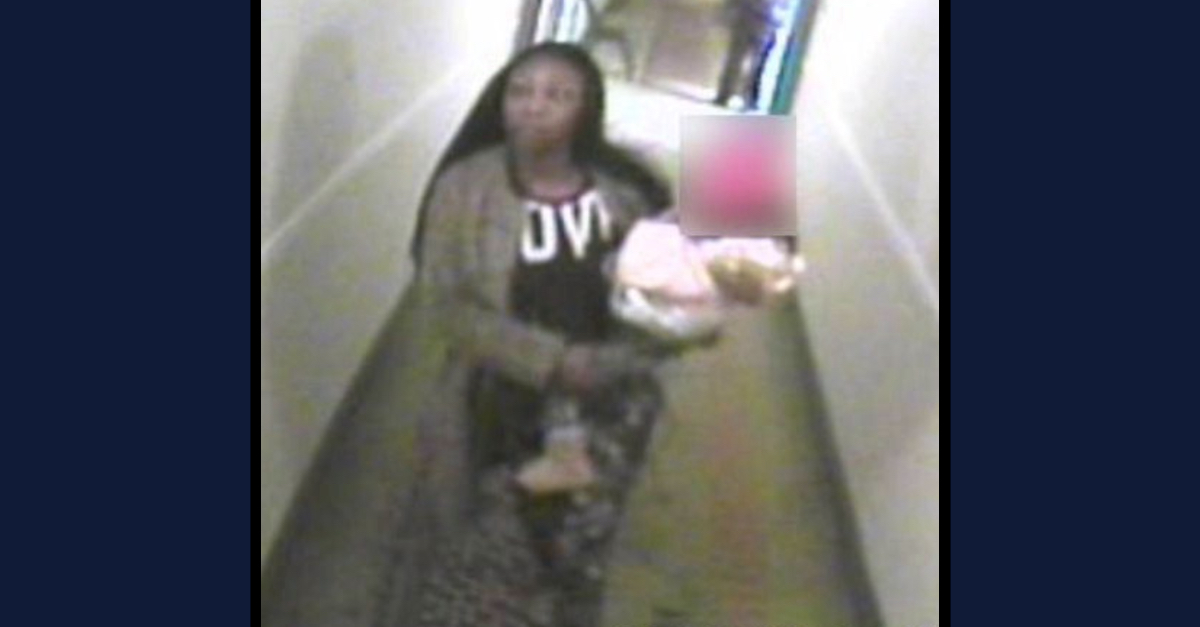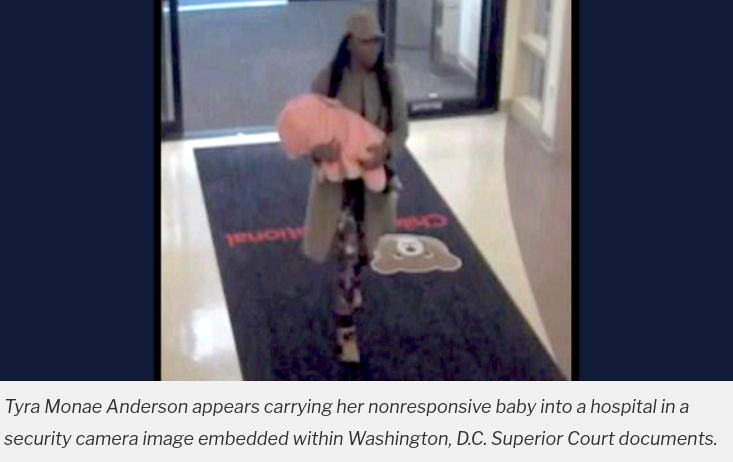A Washington, D.C. woman who wrapped her lifeless 11-month-old daughter in a pink blanket and “calmly” walked the infant into a local hospital pleaded guilty on Wednesday to voluntary manslaughter in the baby girl’s February 2020 death.
The case sits on a legal and culture fissure involving punishment and mental illness treatments. Police affidavits suggest that officers were prepared to arrest the defendant on felony murder charges; the ultimate plea was to a charge with substantially reduced punishment.
Tyra Monae Anderson, who is now 28 but who will turn 29 in just a matter of days, was “the parent and primary caregiver” for the child, prosecutors said. She took her mortally wounded daughter to Children’s National Medical Center on Feb. 6, 2020, where the child was pronounced dead. The child, Mackenzie Anderson, died by blunt force trauma to the head, federal prosecutors added, citing medical reports and an autopsy.
“The plea, which is contingent upon the Court’s approval, calls for a 10-year prison term, with all but three years of that time suspended on the condition that Anderson have no future unsupervised contact with children and that she engage in mental health treatment,” the U.S. Department of Justice said in a press release. “Following the prison term, Anderson is to be placed on five years of supervised release.”
In other words, prosecutors have agreed that the defendant should spend three years behind bars and receive otherwise favorable treatment if she agrees to the aforementioned conditions. If she fails, she will remain incarcerated or be returned to prison.
An autopsy revealed that “make-up or some type of cosmetic” appeared to have been applied to Mackenzie’s body to cover up “multiple contusions to the head and face,” the DOJ added. “Following a search warrant, cosmetics were recovered from the hotel room. The autopsy determined that the child suffered from multiple contusions to the face and head, skull fractures, and other injuries.”
When questioned by police, however, the defendant gave another explanation for the cosmetics.
“I don’t wear make-up,” the defendant said, according to a nearly 40-page police affidavit. “[I]t’s makeup in the room because the kids play with the makeup.”
Prosecutors further illustrated the facts as follows:
Anderson, who was residing at a hotel in the 1600 block of New York Avenue NE, told law enforcement that the child fell from a bed on or about Feb. 3, 2020. She stated that the child “was not active and not acting like herself” the following day, and that she was gasping for air on Feb. 5. Finally, on Feb. 6, she stated, she found the child unresponsive and cold to the touch. She maintained that she did not seek immediate medical attention because she was scared.
A lengthy investigation resulted in the mother’s arrest many months later on Dec. 4, 2020. Initial news reports on the incident said the hotel was functioning as a homeless shelter when the baby died.
The police affidavits contain a broader narrative than that provided by prosecutors. They say the staff at Children’s National Medical Center immediately suspected either “domestic violence” or “physical abuse” when Anderson arrived with her nonresponsive baby. The staff immediately began lifesaving measures, called the police, and said the defendant would remain detained until officers arrived.
As part of the police probe, officers obtained surveillance camera images from the hotel where the defendant was staying. Those images suggested that Mackenzie was last seen alive on Feb. 1, 2020. Subsequent images captured the defendant with another of her children, a 20-month-old, on Feb. 2, Feb. 3, and Feb. 5 — but Mackenzie was not present. Hotel staff told the police that Anderson refused housekeeping services on Feb. 5 and stayed in her room that day.

Hotel security footage dated Feb. 1, 2020, shows Tyra Monae Anderson carrying her 11-month-old daughter Mackenzie in her left arm while leading another of her children by the hand.
Images from Feb. 6, 2020, showed the defendant “carrying what appears to be the decedent’s lifeless body before arriving” at the hospital “with the decedent wrapped in a blanket.”
The defendant was described as “clearly distraught” at the hospital. She said she and her four children were living at the hotel but that two children were also staying with family members so they could be close to school.
After saying that Mackenzie had fallen from a bed, the defendant told hospital staff that Mackenzie “falls often,” had suffered from “shaking episodes,” and eventually died with “blood [bruise] pooling in her face and in her mouth.”
“Isn’t that fucked up?” the defendant reportedly said to hospital staff with reference to the infant’s condition.
The defendant told staffers that she had been “diagnosed with anxiety and panic attacks and possibly bipolar disorder,” the police report says. It also says the defendant seemed “fixated on getting her medications after the decedent was pronounced dead.”

Tyra Monae Anderson appears in a surveillance camera image embedded within Washington, D.C. Superior Court documents.
During a subsequent police interview, the defendant told investigators that Mackenzie was trying to “reach for something and fell” from the bed while she (the defendant) was looking at her cell phone. According to police documents, the defendant said she then “started crying and ‘kind of’ shook the decedent” before “performing chest and stomach compressions.”
The defendant then told the officers that the infant “started shaking, as if having a seizure” later that same day. The defendant said her only course of action was to feed the baby and to put her to bed. The next day, the baby was “not active and not acting like herself,” the police affidavits continue, citing the defendant’s statements to the police. “The decedent was no longer able to hold herself up or stand on her own,” the report also said; a bump had formed on the side of the infant’s head that was “soft like jello,” the defendant added.
The next day, the defendant said she left the infant in the bathtub with another child “for about five (5) minutes.” When the defendant returned, the decedent was bent over at the waist; when she called the baby’s name, the infant “popped up” and was “gasping for air.”
The defendant said she began chest compressions which resulted in “water and foam coming from the decedent’s mouth and nose,” according to one police affidavit’s retelling of the conversation. The defendant said she again started crying, gave the baby “a bottle of milk and some food from the dinner tray,” and that the baby fell asleep.
The following day, the defendant woke up to find the baby “cold to the touch,” the police report continues. The defendant said she didn’t seek immediate attention for the baby girl because she was scared.
The defendant alternately described her baby as a “happy baby” with a “bright smile” and as a “greedy and lazy” infant. When asked why she would refer to a baby as “greedy and lazy,” the defendant reportedly said it was “because that’s all she do [sic] is eat and sit around.”
After discussing whether she needed a lawyer — the police told her they didn’t think she did, a common response to a noncustodial interrogation and a ploy to keep the suspect talking — the defendant asked if she could go to a convenience store. She was told she was free to leave, so she did; she did not return to continue the interview.
According to the police records, the little girl’s father was barred from visiting the hotel where the defendant and Mackenzie were living due to a prior domestic incident with the defendant. The father said he had not been alone with his children for several weeks prior to Mackenzie’s death. He said he came to pick Mackenzie and the defendant up from the hotel, however, because the defendant called him and said the infant was “acting funny” and needed medical attention. The father told the police that he only saw a scratch on the infant but did not get a good view of his daughter because the baby was wrapped in the aforementioned pink blanket. The father said that the 11-month-old victim and one of the defendant’s other children would sometimes fight and that he assumed the scratch was the result of such an altercation. The father also said that he was with Mackenzie and the defendant at a movie theater on Feb. 5 — the day before the baby was taken to the hospital — and that the infant ate some popcorn and otherwise looked fine.
The father said he received a call about 30 minutes after dropping her and his daughter off at the hospital. Anderson told the father that Mackenzie had died of a “skull injury.”
In a subsequent interview, the father said he didn’t know what happened to his daughter when approached by police and by a social worker about whether he learned any additional details — presumably from the defendant. The affidavits suggest the father was being evasive because he answered questions about whether he had information about his daughter’s death with a conclusion that he didn’t know what happened.

Tyra Monae Anderson appears in a surveillance camera image embedded within Washington, D.C. Superior Court documents.
The police report says that in addition to “contusions to the face and body” and “abrasions to the face, neck and hands,” Mackenzie suffered “discoloration to both legs.”
A doctor at the hospital, Dr. Joanna Cohen, said the infant died by “non-accidental head trauma.”
An autopsy revealed that the baby “suffered from multiple acute contusions to the face and head, acute skull fractures, a laceration to the upper frenulum, a laceration inside the left ear, pulmonary edema, and hemorrhaging in the bilateral optic nerve sleeve,” the police reports also indicated. “The decedent had very little stomach content and had firm, dark stool in her bowels.”
Other witnesses reported seeing injuries on the baby a few days prior to the little girl’s death. Those injuries included a bump on the girl’s head “and a scab on one of her hands.” That same witness said she had a “bad vibe” about the baby’s health.
Subsequent police work questioned whether the baby’s father could have played a role in her death. According to one witness, the defendant tried to blame the father during one of several several shifting and inconsistent accounts of what happened. Myriad confidential tips, witness statements, and statements from relatives — some of them packed with scandalous and salacious allegations — led the police to probe further.
Officers went through hours of surveillance video to catalogue the defendant’s movements in and around the hotel where she lived. Several of those recordings contained the concomitant comings and goings of the father’s white four-door vehicle in the area near the hotel. One recording showed the defendant walking toward the father’s car on Feb. 3 in a video with a 12:34 timestamp; an already “limp” Mackenzie was in her arms — perhaps suggesting the child was injured outside the father’s presence.
According to the affidavits, the videos showed several additional contacts between the father’s car and the defendant. Sometimes the victim was present; sometimes she wasn’t. The recordings appear to present an incomplete timeline at best. The reporting officers do not suggest where the victim might have been when she was not visible in the recordings; they likewise do not indicate that the father was, indeed, the person behind the wheel when the car when it was seen on camera. The father was confronted with this video evidence; the police even told him it contradicted some of his earlier statements. He expressed agitation and said he didn’t know how his daughter died. Officers also wrote that surveillance video from the movie theater the father claimed to visit contained no evidence whatsoever that the visit actually occurred.
The police reports in Anderson’s case do not suggest that the father should or would be charged with a crime. Initial news reports on the incident suggest he was not charged; the Washington, D.C. Metropolitan Police Department has not confirmed whether the father was arrested or charged in response to Law&Crime emails seeking additional information.
Some witnesses claimed a member of law enforcement was related to the family and informally intervened in family disputes; that law enforcement official denied any such involvement. Other documented tips contained accusations that the police refuted as false as the case unfolded; one tipster was clearly and erroneously “comingling” [sic] various people in the infant’s life, the police noted.
Ultimately, the police wrote that they believed the defendant “intentionally inflicted” the fatal injuries “and/or failed to seek immediate medical treatment” — thus being the ultimate person who “caused the decedent’s death.” One section of the police report concluded — perhaps overzealously — that Mackenzie was in the defendant’s “exclusive care and custody for the week prior to her death.” Prosecutors, according to their press release, were more cautious in their assessment; they simply rationed that the defendant was the victim’s “parent and primary caregiver” to satisfy legal causation and to secure a plea — albeit to a lesser charge.
Police initially sought to accuse the defendant of felony murder by way of first-degree cruelty to children; the plea agreement resulted in a much lesser charge of voluntary manslaughter.
Under Washington, D.C.’s murder statute, a person must be “of sound memory and discretion” to be charged with first-degree murder or felony murder. Felony murder involves a death which occurred “without purpose” in connection with another named crime — here, first-degree cruelty to children, as mentioned above. (First-degree murder involves “deliberate and premeditated malice or . . . poison,” which are not part of the facts of this case.)
A felony murder conviction — since the crime is technically a subset of the first-degree murder statute — could have carried a sentence of between thirty years and life in prison. A manslaughter conviction could have resulted in a sentence of up to 30 years in prison.
Formal sentencing is scheduled for March 31, 2022.

Pingback: Mom Accused of Munchausen-by-Proxy Medical Abuse of Weeks-Old Infant - Priceless Diamonds Inc.
Pingback: Mom Accused of Munchausen-by-Proxy Medical Abuse of Weeks-Old Infant
Pingback: Mom Charged After Video Circulates of Her Violently Shaking Her 4-Month-Old Son - Priceless Diamonds Inc.
Pingback: Indiana Teen Gets 100 Years in Prison for Smothering His Toddler Siblings to Death in 2 Separate Killings - Priceless Diamonds Inc.